Natural After-Death Care at Silver Sage, an Urban Senior Cohousing Community
In 2007 Henry and Jean were founding members of Silver Sage Village in Boulder, one of the earliest senior cohousing communities in the US. In the early years Jean had been enthusiastic in recruiting new members, but her suspicion she had early-onset Alzheimer’s was confirmed at age 63 and then worsened rapidly after a fall from her bicycle. Henry was devoted to caring for his wife and even led a support group for caregivers through the Alzheimer’s Association. He accompanied Jean to the end, first finding an adult day-program for her to attend, then bringing part-time caregivers into their home at Silver Sage and eventually visiting her twice a day throughout her final three years in a nearby memory-care facility.
The community loved and supported Jean and Henry, but once she moved into memory care we were unable to do much more than recognize and make allowances for the demands and stress on Henry and save him plates of food on nights when there were Community Dinners. Although Jean no longer recognized or responded when we visited, a couple of us helped fill in for Henry at the memory care facility to help Jean with lunch on the rare times Henry went on trips.
Henry had talked with Jean earlier and knew she wanted to be cremated, but what kind of funeral or celebration of life would he want to create for her? Henry and Jean had no children and no relatives in Colorado, but they had both been active in the Unitarian Universalist Church and had a wealth of friends. Henry’s original idea had been to hold a ceremony at the outdoor amphitheater overlooking Boulder, but then he discovered that it might be possible for us to take care of Jean’s body ourselves and to hold her funeral at Silver Sage. That is eventually what happened, in March of 2019.
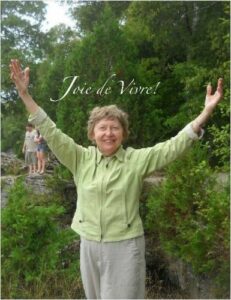
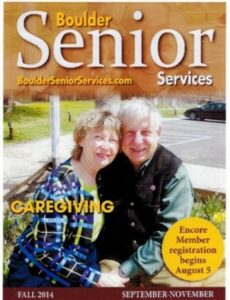
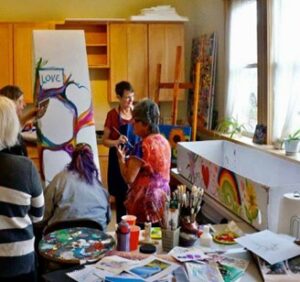
When it looked like Jean was close to death, Henry purchased a cardboard casket from The Natural Funeral and invited community members to paint it and attach poems and letters for Jean. He also shared the video “In the Parlor: The Final Goodbye” with the community, which explained how the long history of “taking care of our own” had been disrupted by the Civil War and then had become the province of the funeral industry. The video explained that embalming isn’t necessary or legally required and shows how three different families do a home vigil with their loved one “lying in honor” so family and friends can visit after death and before the burial or cremation. The video is excellent in explaining both the practical aspects of preparing and maintaining the body and the benefits of reclaiming what used to be called a wake or vigil.
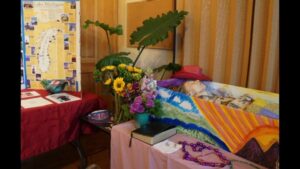 Henry was fortunate to have plenty of help within the Silver Sage community: I had been part of a “Threshold Group” in Sacramento, providing natural after-death care to the extended Steiner/Waldorf community there, and my husband and I had taken care of several members of our extended family in Boulder when they had died. Henry was already familiar with resources in the area, including The Natural Funeral, which we encouraged him to engage to arrange the cremation, transport Jean’s body and handle the paperwork. I told Henry I would be glad to help wash, anoint and dress Jean’s body and maintain the dry ice throughout the vigil, leaving him free to focus on setting up her remembrances and then being with their many friends.
Henry was fortunate to have plenty of help within the Silver Sage community: I had been part of a “Threshold Group” in Sacramento, providing natural after-death care to the extended Steiner/Waldorf community there, and my husband and I had taken care of several members of our extended family in Boulder when they had died. Henry was already familiar with resources in the area, including The Natural Funeral, which we encouraged him to engage to arrange the cremation, transport Jean’s body and handle the paperwork. I told Henry I would be glad to help wash, anoint and dress Jean’s body and maintain the dry ice throughout the vigil, leaving him free to focus on setting up her remembrances and then being with their many friends.
After this initial flurry of activity, Jean rallied and managed to hang on for another eleven months. During that time we showed a second video, “The Art of Natural Death Care,” (free on Vimeo and well worth the 30 minutes!). We were also able to address more questions from the community about holding a vigil at Silver Sage. Vigils can range from a few hours to several days, and may involve prayers, readings, singing, or simply coming together to share stories and to bear witness to a person’s life and death. The Natural Funeral’s website explains, “Families may find it healing to have this additional time to take in the significance of their loved-one’s departure in their own unique way, without the need to hurry.” This was certainly the case for Henry, although he wasn’t sure how long he would want the vigil to last.
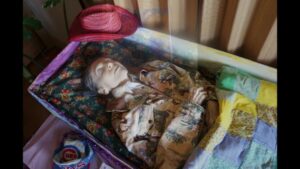 My experience in working with families has been that waiting three days before the burial or cremation can provide enough time and space for a real change in the grieving process to occur—with my own father we had a strong sense on the third day that he had “moved on” and was no longer associated with his body. And by that time all of us—including my mother who had been married to him for sixty years—were ready to take the next step and let go of his body. But I reassured Henry he could end the vigil whenever he felt it was right to do so.
My experience in working with families has been that waiting three days before the burial or cremation can provide enough time and space for a real change in the grieving process to occur—with my own father we had a strong sense on the third day that he had “moved on” and was no longer associated with his body. And by that time all of us—including my mother who had been married to him for sixty years—were ready to take the next step and let go of his body. But I reassured Henry he could end the vigil whenever he felt it was right to do so.
As an urban senior cohousing community in Boulder, where many of the 28 residents have adult children and grandchildren in the area, Silver Sage differs from some rural intentional communities where death and burial on the land have become an integral part of community life and residents have become family for one another. Natural after-death care was new to most Sagers, and Henry and I needed to submit a description of what we wanted to do and why. We described that Henry would set up a memorial for Jean in the meditation room and that another Sager and I would tend Jean’s body during the vigil, which would last up to three days. During that time Henry would receive visitors from the larger community in the dining room to reminisce, snack together and tell stories. (While someone less extroverted might want to plan something smaller and more intimate—or even stay away during the times of open visitation—this arrangement turned out to be perfect for Henry.) The vigil would end with a funeral service developed by Henry and their Unitarian minister, which more than forty people attended. Click here to see how our Meditation Room was transformed into a “Memorial for Jean” (a 2-minute video).
We explained that residents of Silver Sage would be free to be involved or not, as they wished—for example, it would still be possible to get mail without having to enter the meditation room and view Jean’s body. This was the first time most Sagers had seen or heard of these practices and participation varied, from avoiding the Common House altogether during that time to wanting to work with me to learn how to prepare the body and replace the dry ice.
Celebrating Jean’s life and death together turned out to be a gift for the community as well as for Henry and their many friends in Boulder. Henry explains:
“I am so appreciative of the natural funeral process that invited so many friends, family and community members to show their love for Jean and open their feelings with me during the challenging days and weeks as Jean was leaving the world that we know. The three-day vigil with Jean dressed in her favorite garments surrounded by treasured hats, photos, and remembrances ‘just flowed’ together in unanticipated ways, with visitors and thankfulness for all our Silver Sage members making this unique experience such a blessing during the sadness of losing my dear spouse.”
Attending Jean after her death provided Sagers with the shared experience of dying as part of living in community, and her vigil increased everyone’s awareness that “taking care of our own” is an option for anyone who might want it. However, many residents reported they would still be leaving what happens after they die to their family members—and it was unlikely to include holding a vigil! While I agree that funerals are, in fact, primarily for the benefit of the living, I’m making sure my family knows I’d like a three-day vigil followed by a green burial; within that framework, if or how they work in a funeral or a celebration of life is up to them. Separate from the vigil, the entire experience reinforced for many of us the value of developing our own individual and community ceremonies when one of us dies, especially when the family either doesn’t hold a funeral or doesn’t invite us to the ceremony, which has sometimes happened…..
To share more about natural after-death care with your family or community:
Extensive resources about caring for one’s own after death can now be found online, from how-to guides to online courses and in-person workshops.
“The Art of Natural Death Care,” is a free 27-minute video by Katelyn LaGrega that provides the best introduction to the topic. You can watch it here.
“In the Parlor: The Final Goodbye,” is a professional video by Heidi Boucher. It is more than an hour long and costs $25 to purchase as a DVD, but it is a definitive resource that provides historical context as well as following three families in detail. Learn more.
Nancy Poer taught me how to do natural after-death care more than twenty years ago. Her book, Living into Dying, is subtitled “A Journal of Spiritual and Practical Deathcare for Family and Community”; the video of her brother’s conscious dying in his eighties and after-death care in community (1 hour) can be viewed free here.
We all know how this ends. is a practical and very readable book by Anna Lyons and Louise Winter, a death doula and progressive funeral director in the UK. Described as “Lessons about life and living from working with death and dying,” it explores many things to think about in planning meaningful funerals and life celebrations.
The National Home Funeral Alliance lists laws state by state and is an excellent resource.
About the Author:
 Rahima Baldwin Dancy joined Silver Sage Village senior cohousing in Boulder with her husband, Agaf, in 2014. She started her calling as a homebirth midwife and childbirth activist in Boulder in the 1970s, followed by working as a Waldorf/LifeWays early childhood and parenting educator. She wrote three books on birth and parenting before moving on to eldercare. Starting in 2000 Rahima offered natural after-death care as part of “The Threshold Group” in Sacramento. She completed a Masters in Gerontology and Organizational Change at California State University Sacramento before moving back to Boulder in 2003. She can be reached at Rahimabaldwindancy@gmail.com.
Rahima Baldwin Dancy joined Silver Sage Village senior cohousing in Boulder with her husband, Agaf, in 2014. She started her calling as a homebirth midwife and childbirth activist in Boulder in the 1970s, followed by working as a Waldorf/LifeWays early childhood and parenting educator. She wrote three books on birth and parenting before moving on to eldercare. Starting in 2000 Rahima offered natural after-death care as part of “The Threshold Group” in Sacramento. She completed a Masters in Gerontology and Organizational Change at California State University Sacramento before moving back to Boulder in 2003. She can be reached at Rahimabaldwindancy@gmail.com.
Article copyright 2023 by Rahima Baldwin Dancy. Permission is granted to share it electronically as an attachment, but not to post it online or publish it in print. Thank you!
Category: Uncategorized
Tags:
Views: 13707

